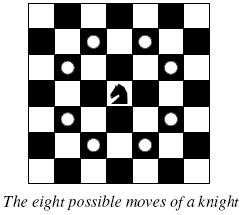poj2488 A Knight's Journey
A Knight's Journey
| Time Limit: 1000MS | Memory Limit: 65536K | |
| Total Submissions: 24840 | Accepted: 8412 |
Description
 Background
Background
The knight is getting bored of seeing the same black and white squares again and again and has decided to make a journey
around the world. Whenever a knight moves, it is two squares in one direction and one square perpendicular to this. The world of a knight is the chessboard he is living on. Our knight lives on a chessboard that has a smaller area than a regular 8 * 8 board, but it is still rectangular. Can you help this adventurous knight to make travel plans?
Problem
Find a path such that the knight visits every square once. The knight can start and end on any square of the board.
Input
The input begins with a positive integer n in the first line. The following lines contain n test cases. Each test case consists of a single line with two positive integers p and q, such that 1 <= p * q <= 26. This represents a p * q chessboard, where p describes how many different square numbers 1, . . . , p exist, q describes how many different square letters exist. These are the first q letters of the Latin alphabet: A, . . .
Output
The output for every scenario begins with a line containing "Scenario #i:", where i is the number of the scenario starting at 1. Then print a single line containing the lexicographically first path that visits all squares of the chessboard with knight moves followed by an empty line. The path should be given on a single line by concatenating the names of the visited squares. Each square name consists of a capital letter followed by a number.
If no such path exist, you should output impossible on a single line.
If no such path exist, you should output impossible on a single line.
Sample Input
3 1 1 2 3 4 3
Sample Output
Scenario #1: A1 Scenario #2: impossible Scenario #3: A1B3C1A2B4C2A3B1C3A4B2C4
Source
简单的深搜,不多说,直接上代码!
#include<iostream>
#include<stdio.h>
#include<cstring>
using namespace std;
int pathlow[30],pathdown[30],visit[30][30];
int dir[8][2]={{-1,-2},{1,-2},{-2,-1},{2,-1},{-2,1},{2,1},{-1,2},{1,2}},n,m;//这里注意是字典序最小
bool dfs(int low,int down,int num)
{
int i,x,y;
if(num==n*m)
{
for(i=0;i<n*m;i++)
{
printf("%c%d",'A'+pathdown[i],pathlow[i]+1);
}
return true;
}
for(i=0;i<8;i++)
{
x=low+dir[i][0];
y=down+dir[i][1];
pathlow[num]=x;
pathdown[num]=y;
if(x>=0&&x<n&&y>=0&&y<m&&(!visit[x][y]))
{
visit[x][y]=1;
if(dfs(x,y,num+1))
{
return true;
}
else
{
visit[x][y]=0;//这里要注意,一定要重新标记为0
}
}
}
return false;
}
int main ()
{
int t,i;
while(scanf("%d",&t)!=EOF)
{
for(i=1;i<=t;i++)
{
printf("Scenario #%d:\n",i);
scanf("%d%d",&n,&m);
memset(visit,0,sizeof(visit));
visit[0][0]=1;
pathlow[0]=0;
pathdown[0]=0;
if(!dfs(0,0,1))
{
printf("impossible");
}
printf("\n\n");
}
}
return 0;
}